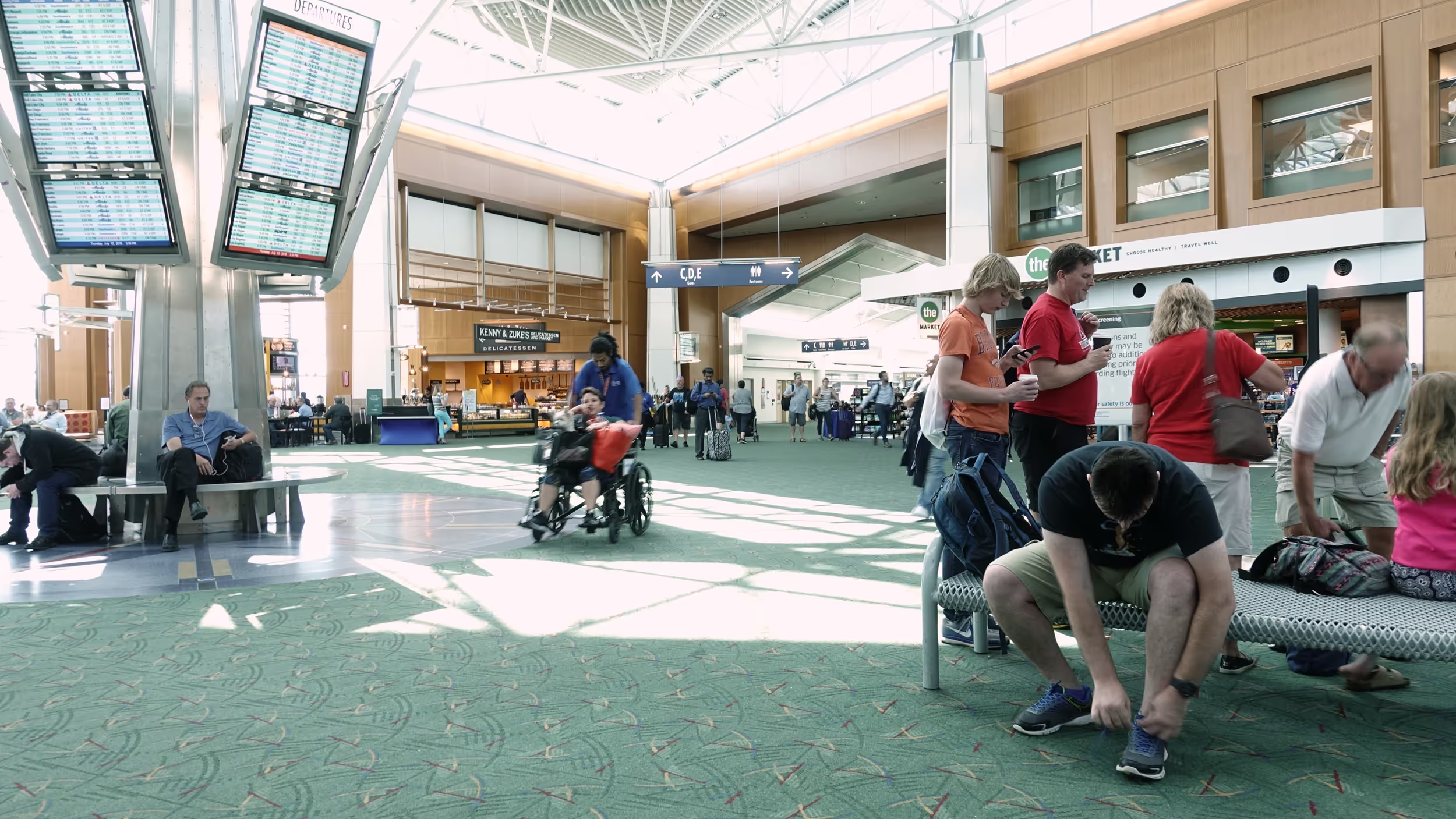Travel Trends for 2024 (and How to Use Them to Your Advantage!)

The doors of travel are cautiously reopening for 2024, and most of us are ready to peek behind them.
What does the new year have in store for those chomping at the bit to explore the world?
As with all things since the COVID-19 pandemic erupted, it’s hard to predict exactly what’s around the corner. But we do know there are some travel trends we can expect to see, barring any more major disruptions.
Whether you’re planning corporate events, business travel, or taking a much-needed and well-earned vacation — you want to be ahead of the trends. Knowing what to expect can help you confidently prepare for your trip.
Right now, the experts are saying the tourism industry is opening back up in (almost) full force.
Here are some of the travel trends and challenges we’re foreseeing on the 2022 horizon.
Table of Contents
1. Increased Personal and Business Travel
2. More International Travel
3. Consistent Transportation Fares
4. Labor Shortages
5. Enhanced Technology
6. Cruising is Back (With Limits)
7. Focus on Sustainable Travel
1. Increased Personal and Business Travel
Since travel restrictions have eased up over the past year, people have been tentatively dipping their toes back into the real world.
Mandated quarantine had an unexpected result:
Individuals who never cared about traveling before are now interested in exploring unknown places.
With the lockdown lifted, next year appears to be a prosperous time to plan getaways that are off-the-beaten-track.
Moving From Video Zooms to In-Person Meetings
But the spike in post-pandemic sightseeing isn’t just personal. As families splurge on travel plans to appease their wanderlust, businesses are revamping their meeting itineraries and travel budgets.
More company owners and managers are back to feeling comfortable sending their staff on corporate travel trips. As long as each employee also feels safe, they get to enjoy the perks of work trips. And virtual conferencing is fading into the background.
While software like Zoom was a lifesaver during the pandemic, they, too, have side effects.
“Zoom exhaustion” is setting in for millions of employees and independent contractors. They need to get out and network in person. As the travel industry continues to open up, business trips are almost back to pre-COVID levels (with new safety policies, of course).
See also: Full Guide to Trip Risk Assessments to Keep Employees Safe
2. More International Travel
Plans for international travel are on the rise — with precautions.
Virus variants like Omicron put a wrench in the smooth reopening of borders in Europe and Asia. The coming year is full of hopeful plane ticket holders crossing their fingers and watching the ever-changing travel guidelines.
Now that the Centers for Disease Control and Prevention (CDC) has approved vaccines for children five and older, families can make international travel a reality.
Mandatory quarantine periods are dropping in countries like Italy and England. Chances are, you’ll still have to have proof of a negative COVID test taken within 24 hours of entry, but these are now inexpensive and simple to find.
What About Cruising and Lodging?
One of the hardest-hit industries during the pandemic was undoubtedly the cruise line business. Behind that was the lodging industry as the CDC scrambled to implement safer policies and procedures.
But now, the World Travel & Tourism Council has officially approved cruising and hotels. The future of travel is looking rosy for people trying to cross destinations off their bucket list.
Only certain hotel brands and cruise lines are certified, though. The Council has a set of health and safety standards that businesses must adhere to in order to receive the Global Safety Stamp of Approval.
Travelers concerned about whether their hotel or cruise line has this safety designation should work with a reputable booking company.
For example, Engine’s filters and parameters are exactly what a corporate manager needs to ensure their staff are heading to safe lodging facilities. With international meetings on the upcoming agenda, it’s essential to partner with a knowledgeable company you can trust.
Traveling out of the country? Read our Travel Manager’s International Travel Checklist for tips on planning your trip.
3. Consistent Transportation Fares

The days of dirt-cheap fares are in the past. It took a little scrambling, but airlines have gotten their financial feet back on the ground.
This is actually a good indicator for the well-being of the travel industry. Consistency means millions of jobs are back on stable footing, and it’s easier to project the cost of your future travel plans.
You can expect to see reasonable rates across the board for U.S. travel, from airfare to car rentals. However, airlines and other transportation companies are still cutting costs because of labor shortages.
New Policies You Can Expect to See
The cost-saving initiatives often fall back on the traveler. You’ll see these changes show up in 2024’s trends through new policies.
Merging Airlines
Some airlines are merging their crews and flights to save money without making significant changes.
For instance, passengers who book a flight through United might see their itinerary has them flying with American (or vice versa). By combining partially sold flights to the same destination, both airlines can massively save on fuel and staff costs.
Passengers book through their preferred company, then are directed to the proper gate for their flight. There’s no disruption, but the airlines are able to reduce costs and increase profits.
Changing Destinations
If you’re used to pre-COVID flying, you might expect the same nonstop flights to your favorite destination. Now, it’s rare to find a trip longer than one hour that doesn’t have at least one layover.
Flight plans and airports are constantly adjusted to keep costs down for travelers and airlines. Your prior go-to air carrier might not fly into your preferred airport anymore. You’ll have to hop a short flight from a nearby larger destination to get there.
Touchless Travel
Transportation is going touchless as much as possible. Trains, planes, and car rentals have upgraded their technology to CDC requirements and beyond.
Passengers can use apps to book their travel, find their boarding info, check in, and get status updates. Contactless boarding is part of almost every airport, train, and bus station.
Learn more: Get to Your Flight Faster with these Airport Security Tips
4. Labor Shortages
If you’ve been in a public venue over the past few months, you’ve likely seen the impact of labor shortages. Signs are on the doors of businesses all over the country asking for patience as the establishments are short-staffed.
This is a combination of a variety of factors.
Airlines, Restaurants, and Lodging Shortages
Airlines, restaurants, and hotels are feeling the strain of this labor shortage. Patrons are increasing at the same time staff is decreasing. In order to keep up with the demand of travel and dining out, both industries have had to make changes.
For example, you may see some adjustments in your favorite restaurant’s menu. With less staff to handle the logistics, many food establishments have cut back on the variety of meals they offer.
Airlines have limited the destinations they’ll fly into, reduced the number of outgoing flights per day, and increased connecting flights.
Labor shortages also impact the hotel industry. Some establishments have reduced how many rooms they book because of the lack of staff. Others end up with complaints because of high demand without enough people to handle check-in and housekeeping.
Some companies ensure availability by working with booking professionals like those at Engine. Since the platform includes up-to-date information on each hotel, this helps avoid booking at an underserved hotel.
The labor shortages are expected to continue through 2024.
Patience and flexible travel plans are the best way to navigate these new and still unclear waters.
Discover: 9 Things to Remember When You’re Traveling for Business
5. Enhanced Technology
Improved sanitizing and healthcare technology are essential if a business wants to succeed in today’s post-COVID world. Even those who rent out an Airbnb have to follow stringent cleaning policies.
Many companies are investing in streamlined technology to make the enhanced standards easier to follow while also dealing with labor shortages.
Rental car agencies and hotels have touchless key pickup and dropoff. Chatbots answer questions or direct clients to a person after vetting the reason for the call.
Rebranding
As important as policies and protocols for existing clients are, it’s also essential to attract new ones. The world is slowly opening back up, and businesses must be ready for the floodgates.
Businesses are redesigning current obsolete practices. Expect to see lots of old companies revamping their image in 2024, focusing on sustainability and upgraded amenities that include self-care and wellness.
However, 2024 brings continued hotel openings with the newest technology platforms. Some brands will open with a focus on luxurious sustainability, while others will rebrand their image completely. The goal is to attract the attention of those cabin-fever travelers ready to venture back out and explore the world again.
See also: 12 Traveling Startups and New Travel Tech That Make Business Travel Smoother
6. Cruising is Back (With Limits)

The cruise industry met with substantial obstacles, but many lines are already back on the high seas.
Due to the close contact of passengers in this form of travel, vessels have to include substantial safety policies and procedures in order to open. There are vaccine and testing requirements, port and destination limitations, and more.
Some of the first ships to reopen for operation include Carnival, Disney, Celebrity, Royal Caribbean, and Norwegian. However, every line must follow the new, and possibly permanent, changes to the Passenger Vessel Services Act (PVSA).
As of now, if you’re not vaccinated, put your cruise plans on hold. You can still fly to Mexico or the Bahamas for your once-in-a-lifetime dream vacation. But the logistics of cruising with and without vaccines are still up in the air.
7. Focus on Sustainable Travel
An immensely positive side effect of the coronavirus was a trend toward focusing on local places.
Now that the doors are opening back up, people want to explore, but they want to include travel that benefits the community they’re visiting.
Authentic experiences are a must. Thousands of people are flocking to national parks every day rather than tourist destinations like Paris. Social media feeds are full of unusual travel destinations.
The platform you use to book makes all the difference. Many booking companies still push for big-city itineraries because that’s where they make their money.
Engine helps maximize the sustainable travel experience by allowing the user to choose from various filters. If you’re aiming for an authentic experience, staying in eco-friendly lodging, Engine will help you find precisely what you’re looking for.
Related: How to Travel Green: Eco-Friendly Hotels and More
Conclusion
The ability to predict consumer behavior is a science and social skill that businesses pay big bucks for — especially in the travel industry.
As long as there aren’t any other major disruptions on the horizon, post-pandemic travel is getting back to its new normal.
Whether you’re heading out for that vacation you deserve or a business meeting, these trends will help you prepare for your next trip.
Sign up with Engine now to unlock up to 60% savings on lodging!







.avif)
















![What is an OBT? [+ Why They Matter]](https://cdn.prod.website-files.com/66a41388b1be9ba182f1e80c/66f97c4190ac5e26bea90c05_66a41388b1be9ba182f1efc0_online-booking-tool.avif)











.jpg)

